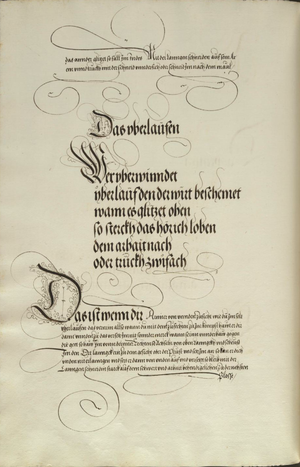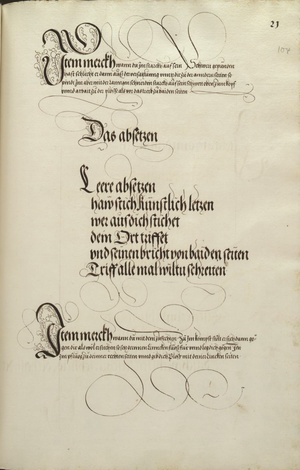|
|
You are not currently logged in. Are you accessing the unsecure (http) portal? Click here to switch to the secure portal. |
User:Kendra Brown/Latin Lew/93r
Jump to navigation
Jump to search
Munich 93r / PDF page 31
Contents
Missing zettel verses from PHM Dresden 103v (Dresden PDF page 44)
German
Das vberlaufen
- Wer vberwinndet
- yberlauf den der wirt beschemet
- wann es glitzet oben
- so sterckh das horich loben
- dem arbait nach
- oder truckh zwifach
English (Fritz)
The overunning
- He who winds over
- will be put to shame by running over.
- When it flashes above
- be strong [against it]. I hear that praised
- according to the work.
- Or press twice.
notes
other copies have uberbinden instead of uberwinden as in lew
93r a
93r a Latin
- SUPERINIECTIO[^2] ENSIS.
- SI quis inferioribus Ictibus te fuerit adgressus,
- hoc modo contra te geras,
- si volveris commemorato habitu uti.
- Cum ad hostem accesseris,
- et is ab infernè contra te feriat,
- excipere ipsius impetum nolito,
- verum diligenter observato,
- cum ipsius ictus inferus tibi adpropinquarit,
- tu de humero[^3] dextro ictum porrectum ferias,
- indeque mucronem longiorem in faciem vel pectus adversarij propellas,
- nec non eum adplices,
- et proposito loco ensem adiungas,
- itaque fiet,
- ut infernè te adprehendere nequeat hostis.
- Si autem is ab infernè ensem levavit,
- tuumque impetum excipiat,
- longa tui ensis acies firmiter hostis ensi inhaereat[^1],
- atque inde celerrimè contra ipsius nuditatem proximam concertato.
- Isthuc tibi quoque observandum est,
- si firmiter ipsius ensem contigeris,
- atque is ex praemunitione[^4] alterum latus tibi ferire conetur,
- tunc acie longa caput eius saucies,
- et aequè contra nuditatem ac prius labores utrinque.
93r a English
- The action of casting over of the sword
- If anyone approached you using strikes from below,
- you should conduct yourself in opposition in this way,
- if you wish to use the aforementioned action,
- When you have come near to the opponent,
- and HE strikes against you from below,
- you will refuse to intercept his forward attack,
- [you] will truly observe carefully,
- when his low strike drew near to you,
- YOU would strike an extended strike from the right upper arm,
- and thence you would thrust forward the longer point into the face or chest of the adversary,
- indeed you land [a strike] on him,
- and if you would connect the sword in the exposed place,
- it will therefore occur
- that the enemy is unable to overtake you from below.
- If HE raises the sword from below
- and he would intercept your forward attack,
- the long edge of your sword stays stuck firmly to the sword of the opponent,
- and thence you will quickly strive against his nearest opening.
- This will likewise have been been observed by you,
- if you have strongly contacted his sword,
- and HE tries to strike out of the fortification at your other side,
- then you wound his head using the long edge,
- and you work the prior [action] equally on both sides and against the openings.
93r a English smoothed draft
- The action of casting the sword over
- If anyone approaches you using strikes from below, conduct yourself in opposition in this way in order to use the aforementioned action.
- When you have come near to your opponent, and they strike against you from below, first refuse to take out their forward attack, then observe carefully when their low strike draws near to you, and strike an extended strike from the right upper arm,
- then thrust forward with the longer point into the adversary's face or chest, and you hit them, and if you connect with the exposed place with your sword, your opponent will be unable to overtake you from below.
- If your opponent raises the sword from below and would take out your forward attack, keep the long edge of your sword stuck firmly to your opponent's sword, then quickly fight against their nearest opening.
- You will have likewise observed this: if you have strongly contacted their sword, and they try to strike out of [your] counterposture at your other side,
- Then use the long edge to wound their head, and work the prior [action] equally on both sides and against the opening.
93r a notes
- [^1]: the underlying sense of this is something staying in place often in a somewhat negative way: words stuck in throat; following too close behind, failing to break through, getting stuck during a race. (It also has non-negative senses.) It makes more sense now that we've read "the long sharp edge of your sword" as the subject of the verb, not the object.
- [^2]: "überlaufen" in relation to weapons means to attack [from above], and is synonymous with anfechten or schlagen, Grimm, vol. 23, col. 379. "Iniectio" means to throw, cast. "Superiniectio" means to cast your sword over a highline attack so that your tip drops downward to hit something.
- Parallel construction, two targets, present in German
- organization:
- 1-3: outline
- 4-7: theoretical
- 8-14: practical example
- 15-18: second practical example
- 19-23: third practical example
- [^3] German has shoulder here; Latin has "humero" instead of expected "brachio"
- [^4]: The German has a standard "Versatzung" here, while the Latin has this 'preparatory' form of 'munito', which means the act of fortification or guarding. This is possibly a synonym for "castra", which is used for the guards/stances.
Missing zettel verses from PHM Dresden 104r (Dresden PDF page 45)
German
Das absetzen
- Leere absetzen
- haw stich Kunstlich letzen
- wer auf dich stichet
- dem Ort triffet
- vnd seinen bricht von baiden seiten
- Triff alle mal wiltu schreiten
English (Fritz)
The setting-aside
- Learn Absetzen (setting off).
- Foil artfully strikes and thrusts.
- Your point will hit
- the one who thrusts against you
- and his point will be broken by yours.
- Hit from both sides each time you want to step.
93r b
93r b Latin (sandbox)
- REMOTIONIS[^5] HABITUS ET VSVS
- ID hoc modo exercebis,
- si ad adversarium proceßeris,
- atque is quasi pungere velit se constituerit,
- tu sinistrum pedem prepones,
- necnon versus ipsum in Aratrum co[m]ponas te,
- ex latere dextro tuo,
- nudumque latus hosti sinistrum praebeas,
- cum igitur nuditatem fodere conetur,
- ensem deflectas in latus sinistrum tuum versus ipsius ensem,
- et brevi acie,
- eius ensi coniungas,
- et ea conditione hostis impetum removeas[^6] mucrone tamen contra hostem porrecto,
- sinistro post dextro pedi coniuncto,
- faciem inde vel pectus fodias.
93r b English (sandbox)
- The gesture and use of deflection
- You will practice THIS in this way,
- if you were to advance toward the adversary,
- and HE were to arrange himself as if he wanted to feint a thrust[^9],
- YOU[^7] place your left foot forward,
- and indeed, you would compose yourself in the plow against that one,
- out of your right side,
- and you should offer an openness in the left side to the enemy,
- When, therefore, he would attempt to stab the opening,
- you should divert the sword aside into your left side against his sword,
- and the short edge,
- you should join to his sword,
- and you deflect the forward attack of the enemy with this deep thrust, still extending the point against the enemy,
- the right foot having been joined behind the left,
- from there you should stab at the face or chest.[^8]
93r b English smoothed draft
- The gesture and use of deflection
- If you want to practice like this, advance toward your opponent, and they will arrange themself as if they want to prick;
- place your left foot forward, and compose yourself in plow on your right against your opponent.
- you should expose an opening on your left side to your opponent,
- and therefore they will attempt to stab the opening.
- turn your sword aside into your left side against their sword, and join your short edge to their sword,
- and you deflect your opponent's forward attack with this deep thrust, while still extending the point against them,
- the right foot having been joined behind the left, from there you should stab at their face or chest.
93r b notes
- [^5]: remotio used for 'absetzen'
- [^6]: removeas used for 'absetzen'
- [^7]: This line is an imperative, which means the verb already includes the implied subject, yet the pronoun 'tu' is included as well.
- [^8]: The German has 'indes' in this clause, meaning that you stab their face or chest while stepping forward. This is an example of the Latin translator weaponizing grammar to express Indes. Lines 13-15 form a chiasmus in the sequence of tenses, where 13 describes an action [removeas] to be undertaken while an underlying condition is maintained [mucrone porrecto], and line 14 describes the underlying condition [sinestro coniuncto] while the action is undertaken [fodias].
- This is the first page with an ß in the Latin text, which could indicate a new translator, which could indicate that this is the translator's first (and only) exposure to the concept of indes.
- [^9]: The use of 'pungere' here accurately distinguishes between the feinting action of the subjunctive and the actual stab (fodias) from line 15
- parallel construction, two targets, present in german
- 11-12 would normally be combined in Latin, German, and English, but the comma is preserved as it appears in the Latin text.
- A variety of different punctuation choices and letter forms appear for the first time on this page: ß, hybrid a/A on Aratrum, extra period before fodias at the end, random dot above brevi, extra comma between lines 11&12. This could indicate a different scribe has taken over the work.
93r c
93r c Latin (Sandbox)
- ALIA FORMA PRAECEDENTIS.
- SI in Aratri habitu de latere dextro consistas,
- et adversarius nuditatem sinistri lateris supernè conetur ferire,
- tu sublato ense,
- contra ipsius Ictum in latus sinistrum eum convertas [page 32] capulo in forma Bovis pro facie tua constituto,
- alterum pedem si dextro adiunxeris,
- faciem inde vel pectus adversarij pungas,
- idque ex Aratro de latere sinistro facias.
93r c English (sandbox)
- Another form of the preceding
- If you stand in the posture of the Plow on the right side,
- and the adversary attempts to strike the opening on the left side from above,
- YOU, having lifted the sword,
- turn it back against his strike toward the left side with the sword hilt positioned in the form of the Ox in front of your face,
- if you have joined the second foot to the right,
- thence thrust at the face or the chest of the adversary,
- and you could do IT from the Plow on the left side.
93r c English smoothed draft
- Another form of the preceding
- If you stand in the posture of the Plow on the right side, and your opponent attempts to strike the opening on the left side from above,
- Lift your sword, then turn it back against their strike in the left side with the sword hilt in front of your face as in the form of the Ox,
- join the second foot to the right, then thrust at your opponent's face or the chest, and you can also do this from the Plow on the left side.
93r c notes
- parallel construction, two targets, in german


